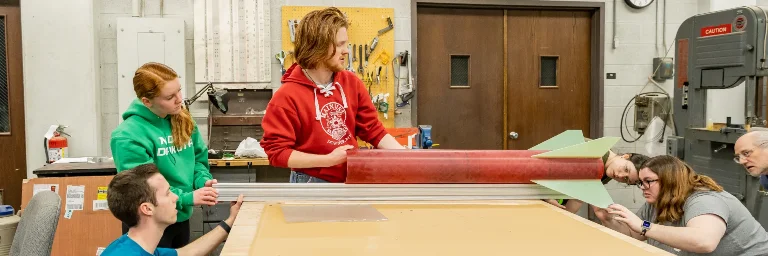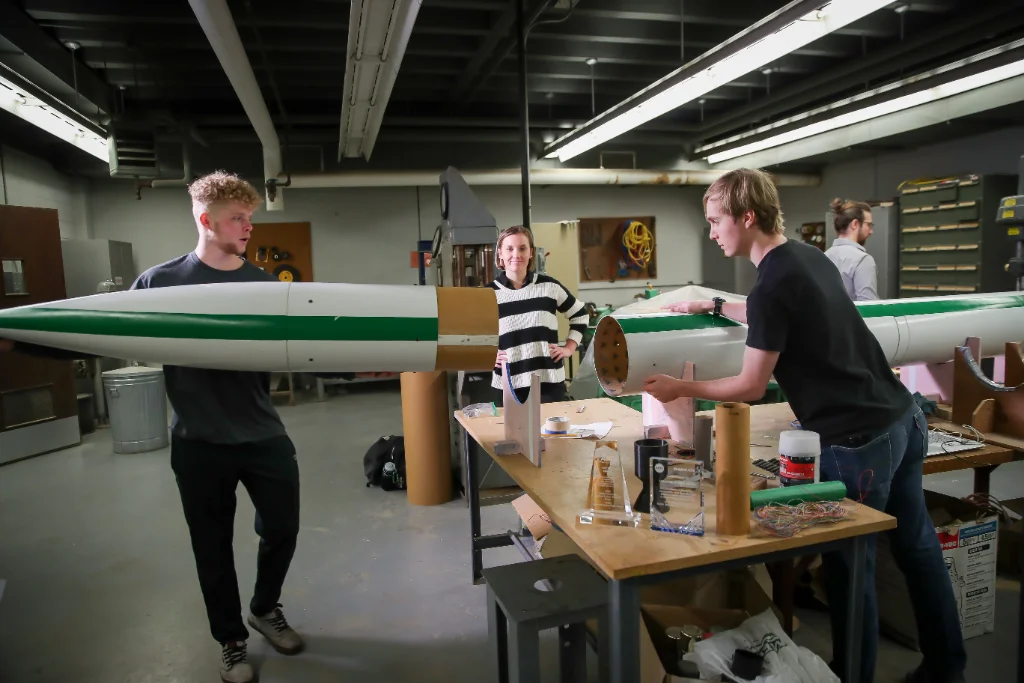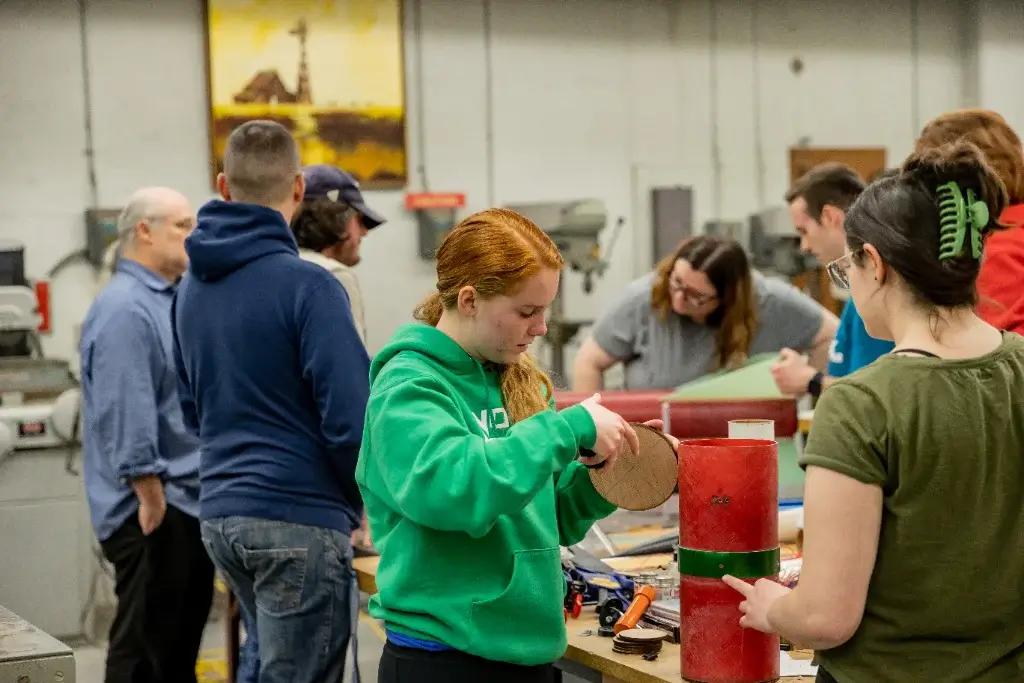
What Can You Do With an Aerospace Engineering Degree?
When we envision aerospace, our thoughts often drift to the daring exploits of pilots navigating the skies or the adventurous voyages of astronauts venturing beyond our earthly realm.
Request Information
Yet, the field of aerospace encompasses a myriad of career avenues beyond just gravity-defying aviators. Aerospace engineering, for instance, serves as the driving force behind the machinery that enables such extraordinary feats.
So, what can you do with an aerospace engineering degree? That's precisely what we'll answer as we explore this exhilarating field. So, keep reading and find out more about the limitless possibilities awaiting those who dare to reach for the stars.
Career Paths in Aerospace Engineering
The field of aerospace engineering is vast, offering a wide range of opportunities and career trajectories. From designing aircraft to developing spacecraft, let's go through some aerospace engineering career paths.
Aerospace Engineer
Aerospace engineers specialize in designing, developing, testing, and maintaining aircraft, spacecraft, satellites, and missiles. They apply engineering and physics principles to create and improve aerospace technologies and ensure their safety, performance, and efficiency.
These engineers work on a wide range of projects, from designing new aircraft and spacecraft to improving existing designs and solving complex engineering challenges related to flight dynamics, propulsion systems, aerodynamics, and materials science.
Aircraft Design Engineer
Aircraft design engineers focus on conceptualizing, creating, and improving aircraft and their components. They utilize their expertise in engineering principles, computer-aided design (CAD) software, and aerodynamics to develop innovative designs that meet safety, performance, and regulatory standards.
Additionally, these professionals work closely with other engineering teams to translate conceptual designs into detailed blueprints, specifications, and prototypes. They also conduct simulations, analyses, and tests to validate design concepts and optimize aircraft performance, stability, and efficiency.
Spacecraft Design Engineer
Spacecraft design engineers are responsible for the development and improvement of spacecraft and related systems. They apply their knowledge of aerospace engineering, systems integration, and space mission requirements to create designs that can withstand the harsh environment of space and meet mission objectives.
Moreover, spacecraft design engineers collaborate with scientists, technicians, and other engineering disciplines to design and validate spacecraft subsystems, propulsion systems, thermal control systems, and payload accommodations. They also conduct feasibility studies, risk assessments, and performance analyses to ensure the success of space missions.
Flight Test Engineer
Flight test engineers oversee the testing and evaluation of aircraft performance and safety. They design test plans, instrumentation systems, and data acquisition techniques to collect relevant flight data and assess aircraft behavior under various operating conditions.
Such professionals collaborate with test pilots, flight crews, and ground support teams to execute flight tests safely and effectively. They analyze test data, identify performance anomalies, and recommend design modifications or improvements to enhance aircraft performance, stability, and safety.

Structural Engineer
Structural engineers focus on the design, analysis, and optimization of aircraft structures. They apply principles of structural mechanics, materials science, and finite element analysis to design aircraft components such as wings, fuselages, empennages, and landing gear.
Structural engineers conduct structural analyses, load calculations, and stress tests to validate designs and identify potential failure modes. They collaborate with aerodynamicists, mechanical engineers, and manufacturing specialists to integrate structural components into aircraft assemblies and ensure compliance with regulatory standards.
Mechanical Engineer
Mechanical engineers apply principles of mechanics, thermodynamics, and fluid dynamics to optimize the performance and efficiency of aircraft propulsion, power generation, and control systems.
These engineers design aircraft engines, fuel systems, cooling systems, and environmental control systems to meet performance requirements and regulatory standards. They evaluate system performance, troubleshoot issues, and propose design modifications through simulations, tests, and analyses.
Avionics Engineer
Avionics engineers specialize in designing, integrating, and maintaining aircraft electronics and electrical systems. They develop avionics systems for communication, navigation, surveillance, and control, ensuring they meet safety, reliability, and regulatory standards.
Furthermore, avionics engineers design electronic circuits, software algorithms, and embedded systems to interface with sensors, actuators, displays, and communication networks. They conduct system-level tests, simulations, and validations to verify avionics functionality and performance. Avionics engineers also provide technical support, troubleshooting, and maintenance services for avionics systems installed on aircraft.
Aviation Manager
Aviation managers oversee and coordinate activities related to the operation and maintenance of aircraft within an organization. They prepare detailed reports on flight schedules, maintenance activities, safety incidents, and passenger statistics to inform decision-making and compliance efforts.
These managers also oversee the recruitment, training, and performance evaluation of aviation department staff, including pilots, maintenance technicians, and administrative personnel. They contribute to strategic planning, risk management, and business development initiatives to enhance aviation operations' overall effectiveness and profitability.
Systems Engineer
Systems engineers focus on integrating and optimizing complex systems within aircraft. They apply systems engineering principles, methodologies, and tools to analyze system requirements, develop system architectures, and allocate resources effectively.
Additionally, they conduct trade-off studies, risk assessments, and performance analyses to identify optimal design solutions and mitigate technical risks. They also collaborate with cross-functional teams of engineers, technicians, and stakeholders to define system requirements, validate system designs, and verify system performance.
Manufacturing Engineer
Manufacturing engineers are tasked with designing, implementing, and optimizing aircraft manufacturing processes. They apply principles of manufacturing engineering, production management, and quality assurance to develop production plans, workflow layouts, and process controls.
Manufacturing engineers design manufacturing equipment, tooling, and fixtures to facilitate assembly, machining, and finishing operations. They collaborate with production teams, suppliers, and quality inspectors to monitor manufacturing processes, troubleshoot issues, and improve productivity.
Research and Development (R&D) Engineer
R&D engineers conduct research and development activities to advance aerospace technologies and improve aircraft performance, safety, and efficiency. They conduct research, experiments, and simulations to explore novel concepts, materials, and technologies that can enhance these aspects.
Moreover, R&D engineers collaborate with multidisciplinary teams of scientists, engineers, and technicians to develop prototypes, proof-of-concepts, and pilot projects. They analyze test data, evaluate results, and iterate on designs to refine and optimize solutions.

Educational Pathways for Aerospace Engineering Careers
Careers in aerospace engineering require a strong educational foundation encompassing undergraduate and graduate studies.
Undergraduate Degree Programs
Undergraduate degree programs provide students with fundamental knowledge and skills essential for success in the field. For example, as the standard degree program for this career path, a bachelor's in Aerospace Engineering degree offers specialized coursework tailored to aerospace principles and practices, covering topics such as aerodynamics, propulsion, materials science, and spacecraft design.
Additionally, a bachelor's in Mechanical Engineering degree can also serve as a suitable pathway, offering a broad engineering education with a focus on mechanical systems relevant to aerospace applications. A bachelor's in Aviation Management is also beneficial for those interested in aviation management roles.
Graduate Degree Programs
Graduate degree programs offer advanced studies and specialized training, enabling aerospace engineers to deepen their expertise and pursue leadership positions. A master's or Ph.D. in Aerospace Sciences provides opportunities for research and innovation, allowing students to contribute to cutting-edge advancements in aerospace technology and theory. These advanced degrees equip graduates with the skills needed for academic and research careers, as well as positions in industry and government agencies.
Skills Required for Aerospace Engineering Careers
Aerospace engineering careers demand a diverse set of skills to tackle the complexities of designing and developing aircraft, spacecraft, and related systems.
Technical Skills
Technical skills are essential for aerospace engineering careers, enabling professionals to apply engineering principles and tools effectively. Some of these required technical skills include:
- Proficiency in CAD software
- Understanding of aerodynamics principles
- Knowledge of propulsion systems and their integration into aerospace vehicles’
- Ability to conduct structural analysis and design
- Familiarity with avionics systems, including navigation, communication, and control systems used in aerospace applications
Soft Skills
In addition to technical expertise, soft skills are needed in aerospace engineering careers, such as:
- Strong analytical skills
- Excellent communication skills
- Teamwork and collaboration skills
- Adaptability and flexibility
- Attention to detail and precision
How to Choose the Right Career Path in Aerospace Engineering?
When it comes to choosing a career path in aerospace engineering, it is important to take into account your interests, strengths, and goals. Firstly, you need to determine your preferred area of focus within the field, whether it's aircraft design, propulsion systems, or space exploration.
Then, research various career options to learn about job prospects, potential salaries, and work-life balance. Seeking guidance from experienced professionals and mentors can help you understand the realities of each path.
Finally, evaluate how each option aligns with your lifestyle and aspirations to make a well-informed decision that will lead to a fulfilling career in aerospace engineering.
Conclusion
As you explore the various career paths within aerospace engineering, consider the programs offered by UND to help you succeed in whichever one you choose. Whether you're interested in aircraft design, spacecraft development, or any other aspect of aerospace engineering, our programs provide the knowledge and skills you need to excel.
So, dream big, aim high, and achieve your goals in aerospace engineering with UND as your partner.
FAQs
Yes, aerospace engineers can specialize in various areas, such as propulsion, materials science, or aerodynamics, allowing them to focus on specific aspects of aircraft design and development.
Aerospace engineers are hired by industries such as aerospace manufacturing companies, defense contractors, government agencies, research institutions, and commercial airlines. They may also work in related fields, such as automotive and space exploration.
Yes, aerospace engineers can work in both government agencies like NASA and private companies like SpaceX.
The typical salary range for aerospace engineers spans from approximately $85,350 to over $205,850 per year, with variations based on factors such as experience, education, location, and employer.